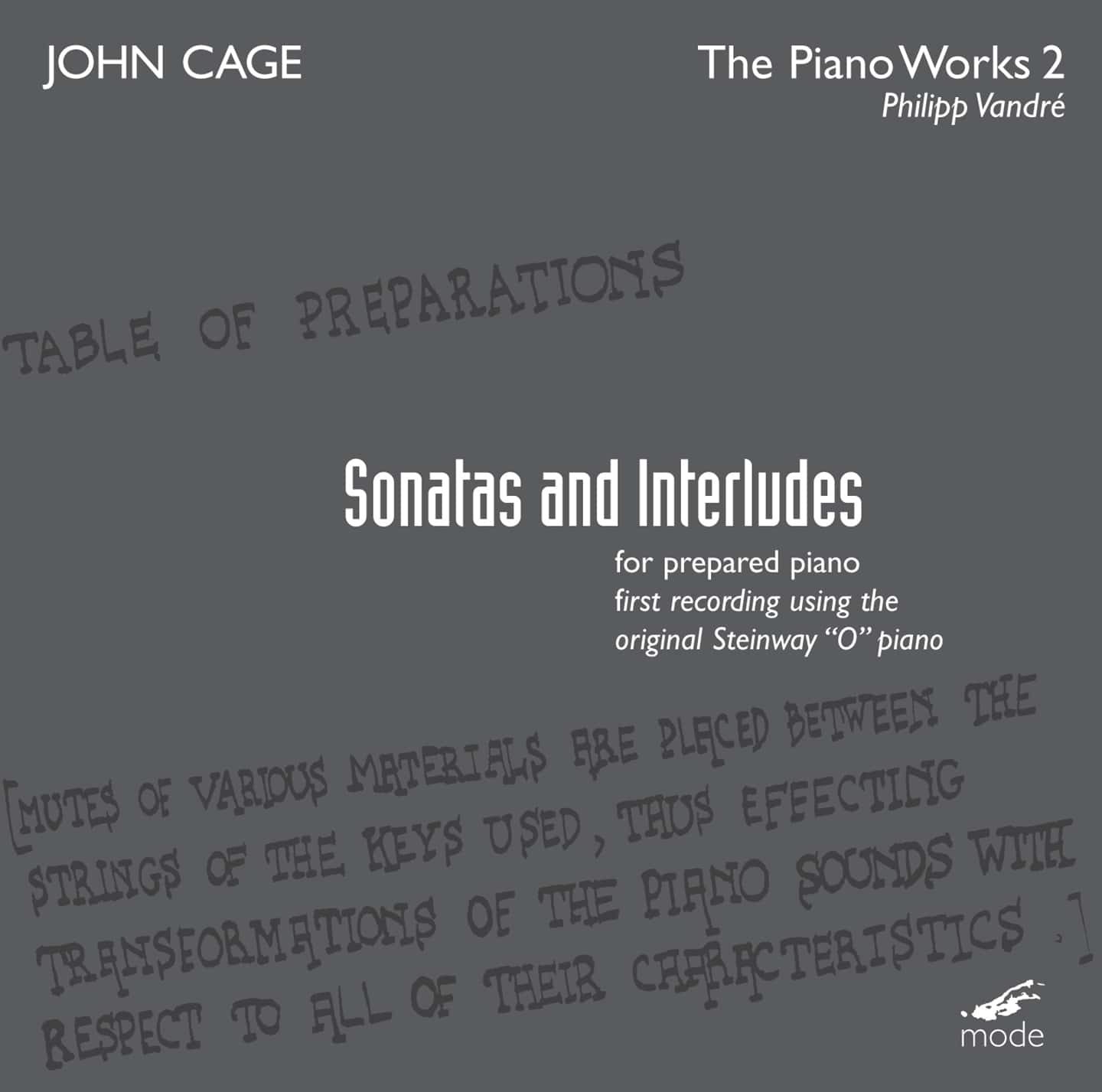Cage Edition 14-The Piano Works 2
Philipp Vandré, prepared piano
First recording using a Steinway “O”-type baby grand piano (as Cage originally composed on and designed the piece for).
First recording to address and clarify several discrepancies in the printed score.
Liner notes by James Pritchett and Vandré.
“The substance of John Cage’s music is elusive. It cannot be taught. It is intangible.”– Peggy Glanville-Hicks
writing about John Cage in Musical America, September 1948
The Sonatas and Interludes enjoy a well deserved reputation as a masterwork and as a repertoire piece.But this is not a masterwork in the sense of other keyboard masterworks: Bach’s Goldbergs, Beethoven’sDiabelli Variations, Ives’ Concord Sonata.
Cage’s masterwork is quite different — a big piece with a quiet voice. The prepared piano operatesentirely by muting: by attaching objects to the strings of the piano. Cage alters their sounds invarious ways, turning the piano into a percussion orchestra akin to a gamelan. The results are differentfrom note to note — resonant, dry, metallic, wooden — but always quieter than before. The preparedpiano is an instrument that is personal and intimate.
Cage quietly and patiently built his large piece out of short structures. By constructing thework on the timeless foundation of Hindu aesthetics, he made each piece perfect and unhurried; focusingon the subtle modulations of his voice, speaking quietly to draw us in to explore thissoftly-colored world.
This new recording by young German pianist Philipp Vandré (a new music specialist whoperforms with Ensemble Modern, Frankfurt Radio Symphony, and his own Turfan Ensemble) is unique. It isthe first recording to use the smaller Steinway “O”-type piano (the same type of piano Cage composed theSonatas and Interludes on) rather than the commonly used grand-piano. Cage gives a detailed table ofpreparations for the strings and the objects to be used, including the exact placement of these objects,in direct relation to the length of the strings of the “O” piano. Vandré learned these detailsfrom the late Yvar Mikhashoff, who received this information from Cage. Because the location of thepreparations is different on a larger piano, they have the effect of making the strings sound lower on alarger instrument. The choice of the piano, therefore, has an immediate effect on the sound of theprepared strings.
Vandré consulted with Cage’s publisher clarifying some subtle details and discrepancies inthe published score, making new corrections and choices which are also recorded for the first time.These details, combined with Vandré’s thoughtful choice of preparations and loving approachto the music, make this the definitive recording of the Sonatas and Interludes
Reviews
JOHN CAGE: Sonatas and Interludes
Philipp Vandre, piano
By Mike Silverton
From La Folia, issue 1.4 (www.lafolia.com)
Brian Brandt’s Mode Records features a flat-out gorgeous Sonatas and Interludes for Prepared Piano as the 14th of its thusfar 17-volume JohnCage series. It is Brian to whom I apply for the inside skinny when I’mshort on facts for a Cage review. He is an authority, as is Mode 50’sannotator, James Pritchett, who includes in his remarks those of PeggyGlanville-Hicks in ’48 and Peter Yates in ’49, when the music was young.The German-born pianist, Philipp Vandre, tells us that for thisrecording he prepared and played a Steinway “O,” the baby grand Cageused, the significance being the sonorities arising from shorterstrings. (The composer Lucia Dlugoszewski recalls at about that time alarger Steinway “B” in Cage’s apartment, an aside I toss in as a wrenchfor extraction elsewhere.) Ernstalbrecht Stiebler, this Mode-HessianRadio co-production’s honcho, is himself an important composer whoseessays in extended tones, Three in One [hatART Now Series CD 6169], andIm Klang [hat[now]ART 109], I heartily recommend, but only toadventurers.
To return to our lush, intimately detailed, hugely accessible Mode,Hessian Radio’s Stephan Schmidt and Ruediger Orth engineered these 1994Frankfurt sessions. As with Stiebler’s austerities, the aleatory Cageremains perforce a taste for the few. The evidence on recording suggeststhat Cage’s ante-chance, predominantly percussive work (including thatfor conventional piano) will secure his longterm popularity, owing ingood part to the music’s energizing transparency and, in the case ofSonatas and Interludes, ominous shadings, which our preparer-performerand production team reveal in the handsomest of terms.
Musik, die eigentlich nicht zu bannen ist,
John Cage: Music for Two, One, Music Walk, One 5 (Drury) Mode 47;
Sonatas & Interludes (Vandré) Mode 50;
Concerto for Prepared Piano and orchestra, Fourteen (Drury), Klavierkonzert (Tudor) Mode 57;
The Seasons, Cheap Imitation, ASLSP (Drury) Mode 63
Längst ist John Cage nicht mehr das Enfant terrible der Neuen Musik, längst nicht mehr der belächelte Provokateur, sondern als Wendepunkt der Musik- und Kunstauffassung unseres Jahrhunderts, wichtiger noch als Schönberg, im Museum der Musikgeschichte verwahrt. Sechs Jahre nach dem Tod sind Cages Werke fest in den konzertsälen etabliert – dort also, wo sie eigentlich hingehören. Nicht nur hatte Cage, der selbst keine Stereoanlage besass, ein gebrochenes Verhältnis zu Musikaufnahmen überhaupt, auch verweigern sich seine indeterminierten Kompositionen der akustischen Konservierung… Dennoch füllen CDs von Cage meterweit die Regale gut sortierter Plattenläden… Die New Yorker Mode Records haben bisher vier Klavierplatten mit Stephen Drury, Philipp Vandré und David Tudor im Programm… Vandré spielt [die Sonatas & Interludes] auf dem 1948 von Cage verwendeten kleinen “Steinway O” und kann daher sicher sein, dass die vorgeschriebenen absoluten Masse für die Orte, an denen die Gummibänder, Schrauben und Plastikstückchen zwischen den Saiten zu klemmen sind, tatsächlich eingehalten werden. So entsteht ein verhältnismässig herber Klang, der Vandré zu einer eher zurückhaltenden Gestaltung angeregt haben mag, deren Spannung haupsächlich in der individuellen artikulatorischen Differenzierung der Klänge liegt.
— Volker Straebel, Der Tagesspiegel, 9. August 1998

